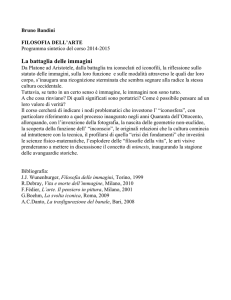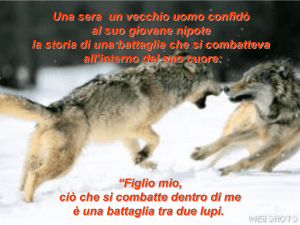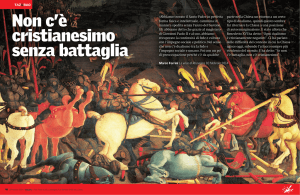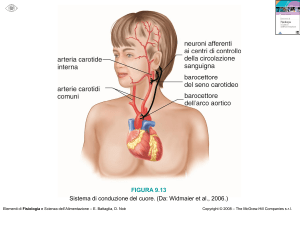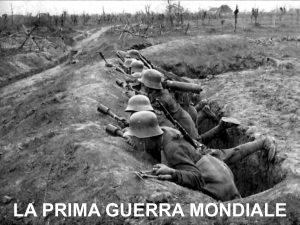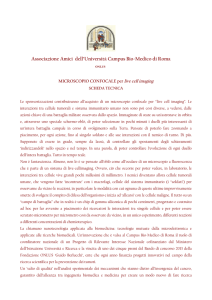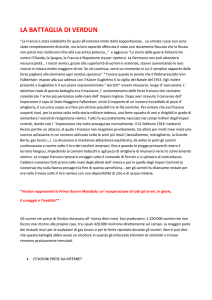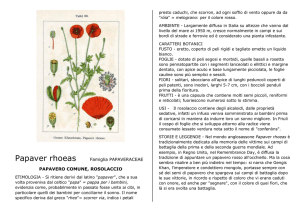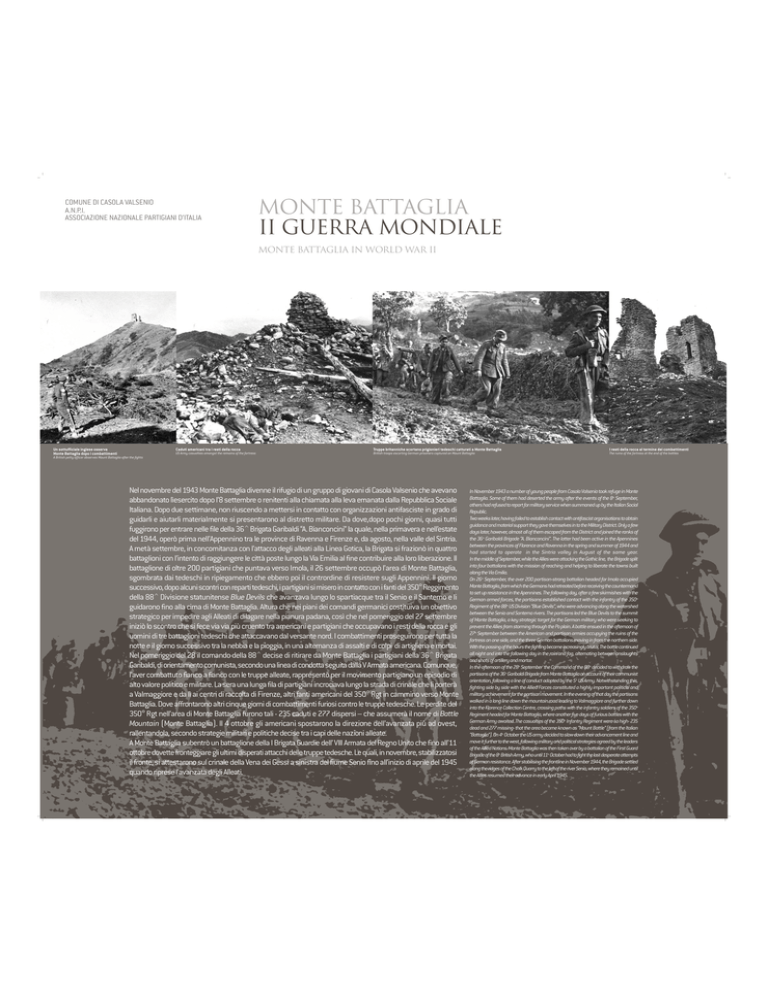
COMUNE DI CASOLA VALSENIO
A.N.P.I.
ASSOCIAZIONE NAZIONALE PARTIGIANI D’ITALIA
Monte Battaglia
II GUERRA MONDIALE
MONTE BATTAGLIA IN WORLD WAR II
Un sottufficiale inglese osserva
Monte Battaglia dopo i combattimenti
Caduti americani tra i resti della rocca
Truppe britanniche scortano prigionieri tedeschi catturati a Monte Battaglia
I resti della rocca al termine dei combattimenti
US Army casualties amongst the remains of the fortress
British troops escorting German prisoners captured on Mount Battaglia
The ruins of the fortress at the end of the battles
A British petty officer observes Mount Battaglia after the fights
Nel novembre del 1943 Monte Battaglia divenne il rifugio di un gruppo di giovani di Casola Valsenio che avevano
abbandonato lìesercito dopo l’8 settembre o renitenti alla chiamata alla leva emanata dalla Repubblica Sociale
Italiana. Dopo due settimane, non riuscendo a mettersi in contatto con organizzazioni antifasciste in grado di
guidarli e aiutarli materialmente si presentarono al distretto militare. Da dove,dopo pochi giorni, quasi tutti
fuggirono per entrare nelle file della 36^ Brigata Garibaldi “A. Bianconcini” la quale, nella primavera e nell’estate
del 1944, operò prima nell’Appennino tra le province di Ravenna e Firenze e, da agosto, nella valle del Sintria.
A metà settembre, in concomitanza con l’attacco degli alleati alla Linea Gotica, la Brigata si frazionò in quattro
battaglioni con l’intento di raggiungere le città poste lungo la Via Emilia al fine contribuire alla loro liberazione. Il
battaglione di oltre 200 partigiani che puntava verso Imola, il 26 settembre occupò l’area di Monte Battaglia,
sgombrata dai tedeschi in ripiegamento che ebbero poi il contrordine di resistere sugli Appennini. Il giorno
successivo, dopo alcuni scontri con reparti tedeschi, i partigiani si misero in contatto con i fanti del 350° Reggimento
della 88^ Divisione statunitense Blue Devils che avanzava lungo lo spartiacque tra il Senio e il Santerno e li
guidarono fino alla cima di Monte Battaglia. Altura che nei piani dei comandi germanici costituiva un obiettivo
strategico per impedire agli Alleati di dilagare nella pianura padana, così che nel pomeriggio del 27 settembre
iniziò lo scontro che si fece via via più cruento tra americani e partigiani che occupavano i resti della rocca e gli
uomini di tre battaglioni tedeschi che attaccavano dal versante nord. I combattimenti proseguirono per tutta la
notte e il giorno successivo tra la nebbia e la pioggia, in una alternanza di assalti e di colpi di artiglieria e mortai.
Nel pomeriggio del 28 il comando della 88^ decise di ritirare da Monte Battaglia i partigiani della 36^ Brigata
Garibaldi, di orientamento comunista, secondo una linea di condotta seguita dalla V Armata americana. Comunque,
l’aver combattuto fianco a fianco con le truppe alleate, rappresentò per il movimento partigiano un episodio di
alto valore politico e militare. La sera una lunga fila di partigiani incrociava lungo la strada di crinale che li porterà
a Valmaggiore e da lì ai centri di raccolta di Firenze, altri fanti americani del 350° Rgt in cammino verso Monte
Battaglia. Dove affrontarono altri cinque giorni di combattimenti furiosi contro le truppe tedesche. Le perdite del
350° Rgt nell’area di Monte Battaglia furono tali - 235 caduti e 277 dispersi – che assumerà il nome di Battle
Mountain (Monte Battaglia). Il 4 ottobre gli americani spostarono la direzione dell’avanzata più ad ovest,
rallentandola, secondo strategie militari e politiche decise tra i capi delle nazioni alleate.
A Monte Battaglia subentrò un battaglione della I Brigata Guardie dell’ VIII Armata del Regno Unito che fino all’11
ottobre dovette fronteggiare gli ultimi disperati attacchi delle truppe tedesche. Le quali, in novembre, stabilizzatosi
il fronte, si attestarono sul crinale della Vena dei Gessi a sinistra del fiume Senio fino all’inizio di aprile del 1945
quando riprese l’avanzata degli Alleati.
In November 1943 a number of young people from Casola Valsenio took refuge in Monte
Battaglia. Some of them had deserted the army after the events of the 8 September,
others had refused to report for military service when summoned up by the Italian Social
Republic.
Two weeks later, having failed to establish contact with antifascist organisations to obtain
guidance and material support they gave themselves in to the Military District. Only a few
days later, however, almost all of them escaped from the District and joined the ranks of
the 36 Garibaldi Brigade “A. Bianconcini”. The latter had been active in the Apennines
between the provinces of Florence and Ravenna in the spring and summer of 1944 and
had started to operate in the Sintria valley in August of the same year.
In the middle of September, while the Allies were attacking the Gothic line, the Brigade split
into four battalions with the mission of reaching and helping to liberate the towns built
along the Via Emilia.
On 26 September, the over 200 partisan-strong battalion headed for Imola occupied
Monte Battaglia, from which the Germans had retreated before receiving the countermand
to set up resistance in the Apennines. The following day, after a few skirmishes with the
German armed forces, the partisans established contact with the infantry of the 350
Regiment of the 88 US Division “Blue Devils”, who were advancing along the watershed
between the Senio and Santerno rivers. The partisans led the Blue Devils to the summit
of Monte Battaglia, a key strategic target for the German military who were seeking to
prevent the Allies from storming through the Po plain. A battle ensued in the afternoon of
27 September between the American and partisan armies occupying the ruins of the
fortress on one side, and the three German battalions moving in from the northern side.
With the passing of the hours the fighting became increasingly brutal. The battle continued
all night and into the following day in the rain and fog, alternating between onslaughts
and shots of artillery and mortar.
In the afternoon of the 28 September the Command of the 88 decided to withdraw the
partisans of the 36 Garibaldi Brigade from Monte Battaglia on account of their communist
orientation, following a line of conduct adopted by the 5 US Army. Notwithstanding this,
fighting side by side with the Allied Forces constituted a highly important political and
military achievement for the partisan movement. In the evening of that day the partisans
walked in a long line down the mountain road leading to Valmaggiore and further down
into the Florence Collection Centre, crossing paths with the infantry soldiers of the 350
Regiment headed for Monte Battaglia, where another five days of furious battles with the
German Army awaited. The casualties of the 350 Infantry Regiment were so high- 235
dead and 277 missing- that the area became known as “Mount Battle” (from the Italian
“Battaglia”). On 4 October the US army decided to slow down their advancement line and
move it further to the west, following military and political strategies agreed by the leaders
of the Allied Nations. Monte Battaglia was then taken over by a battalion of the First Guard
Brigade of the 8 British Army, who until 11 October had to fight the last desperate attempts
of German resistance. After stabilising the frontline in November 1944, the Brigade settled
along the ridges of the Chalk Quarry to the left of the river Senio, where they remained until
the Allies resumed their advance in early April 1945.
th
th
th
th
th
th
th
th
th
th
th
th
th
th
th
COMUNE DI CASOLA VALSENIO
A.N.P.I.
ASSOCIAZIONE NAZIONALE PARTIGIANI D’ITALIA
Monte Battaglia
MONUMENTO ALLA PACE
E ALLA FRATELLANZA TRA I POPOLI
Monte Battaglia, a monument to Peace and the Brotherhood of Men
Cimitero simbolico (1954)
Manifestazione per il Decennale della Resistenza (6.6.1954)
Gli scavi archeologici ai piedi della torre (1983)
Memorial Cemetery (1954)
Celebrating the 10th anniversary of the Italian Resistance (6.6.1954)
The archaeological excavations at the foot of the tower (1983)
Inaugurazione del monumento
nella Giornata Internazionale della Pace (8/5/1988)
Inauguration of the monument during the International Day
for Peace (8.5.1988)
Dopo la Liberazione il ricordo dei combattimenti di Monte Battaglia rimase vivo non solo tra chi vi aveva partecipato
ma anche tra la popolazione civile. Sulla spinta di un tale ricordo nel 1950, venne realizzato ai piedi della torre un
cimitero simbolico con una sessantina di cipressi. Forte era anche il ricordo tra i partigiani della 36^ Brigata
Garibaldi che nel 1954 inaugurarono una lapide a Monte Battaglia nel corso di una cerimonia celebrativa.
Negli anni che seguirono i resti della rocca, di proprietà privata, subirono un ulteriore e forte degrado, tanto che
negli anni ’60 era visibile solo la torre in condizioni pessime. Tanto che 1973 una Giornata di Studi lanciò un grido
di allarme per salvare ciò che restava della rocca di Monte Battaglia. L’appello venne raccolto con la donazione della
sommità dell’altura al Comune di Casola Valsenio che nel 1983 avviò una bonifica del terreno e una campagna di
scavi archeologici che portarono alla luce la traccia delle mura perimetrali. Quindi, su progetto degli architetti Rita
Rava e Claudio Piersanti, si procedette alla sistemazione dell’area, al consolidamento del recinto murario e alla
ricostruzione dei solai della torre, insieme alla ricucitura di alcune sue parti malmesse.
Il recupero di Monte Battaglia venne celebrato l’8 maggio 1988 con la Giornata Internazionale della Pace con la
partecipazione delle rappresentanze civili e militari italiane, americane e britanniche e dei reduci partigiani.
Nell’occasione venne inaugurato il monumento alla Liberazione e alla Pace, opera in bronzo dello scultore faentino
Aldo Rontini. L’opera rappresenta lo scontro vincente di Davide contro Golia a simboleggiare la vittoria della ragione
sulla forza bruta cioè degli Alleati sui nazifascisti. Ma anche Davide è a terra a significare che in guerra perdono
tutti. A fianco del monumento vennero collocate due targhe a ricordo dei combattimenti e dei caduti partigiani ed
americani, alle quali nel 1990 si affiancò quella dei britannici. La cura e la custodia della rocca e dell’area monumentale
venne affidata all’Associazione Nazionale Partigiani d’Italia (A.N.P.I.) di Casola Valsenio, che oltre a valorizzare Monte
Battaglia, ha allestito nella Casa della Cultura di Casola Valsenio il Centro di Documentazione sulla Guerra di Liberazione
con reperti militari, immagini, documenti, video, manifesti e pubblicazioni sulla guerra in ambito locale. Nel 1998,
col permesso del Comune di Casola Valsenio e l’approvazione dell’Anpi casolana, anche i reduci della 305^ Divisione
della Wehrmacht, il cui reggimento aveva perso 250 uomini nel tentativo di conquistare il monte, poterono collocare
ai piedi della torre, una targa a ricordo dei loro caduti. Lo spirito di pace e fratellanza alimentato dalla presenza della
lapide tedesca, che oltre ai propri caduti ricordava anche quelli avversari, venne rafforzato pochi anni dopo dalla
collocazione, sotto quella tedesca, di una targa di riconciliazione dei reduci britannici. Una successiva cerimonia
di riconciliazione assunse un respiro più ampio, consacrando l’altura come Monte della Pace, per la presenza,
insieme alle autorità civili locali, dei reduci partigiani e di altre nazioni, delle rappresentanze consolari americana,
inglese e tedesca e di una delegazione dell’Esercito Italiano.
Il sentimento di pace fra i popoli e ripudio della guerra che si coglie a Monte Battaglia si fa più forte e duraturo alla
vista dei luoghi di ritrovamento dei resti di alcuni dispersi americani e tedeschi. Luoghi divenuti meta di pellegrinaggio
grazie ai sentieri tracciati dall’Anpi e alle indicazioni con i dati dei caduti.
In the years that followed the Liberation the memory of the battles of Monte
Battaglia remained imprinted on the hearts and minds of both those who had
fought the war and of the civilian population. This led to the creation in 1950
of a memorial cemetery with around 60 cypress trees at the foot of the tower.
The partisans of the 36 Garibaldi Brigade shared the sentiment and in 1954
unveiled a memorial plaque in the course of a remembrance ceremony.
As years went by the ruins of the privately owned fortress fell into such disrepair
that by the 1960s the only visible part was the badly damaged tower. In 1973
a “Study Day” initiative launched an appeal to save what was left of the fortress
of Monte Battaglia. The appeal was successful and the site was donated to the
Municipality of Casola Valsenio, who started land reclamation works and commissioned
a series of archaeological excavations which revealed the remains of the old perimetral
walls. Under the direction of Architects Rita Rava and Claudia Piersanti the whole site
was subsequently restored. The works included rebuilding the perimetral wall and the
ceiling of the tower and repairing the parts that had undergone the most severe damage.
The completion of the restoration works of Monte Battaglia was celebrated on 8 May
with the “International Day for Peace”, an event attended by civilians and militaries from
Italy, the US and Great Britain as well as Partisan veterans. The celebrations unveiled the
bronze “Monument to Liberation and Peace” by Faenza–born sculptor Aldo Rontini. The
work represents David’s victory over Goliath, symbolising the triumph of reason against
brute force, i.e. the victory of the Allies against the German National Socialists. Interestingly,
David, too, is depicted lying on the ground, reminding us that in a war everyone is a loser.
Two plaques were laid to the side of the monument to commemorate the Partisan and
the US soldiers fallen in battle. In 1990 a further plaque was added to commemorate the
British soldiers. The maintenance and conservation of the fortress and monument were
entrusted to the National Association of Italian Partisans (ANPI) of Casola Valsenio. Anpi
was also responsible for the creation of a War of Liberation Documentation Centre within
Casola Valsenio’s “House of Culture”. The Documentation Centre displays war memorabilia,
images, documents, videos, placards and new on the war as featured in the local press.
In 1998 with the permission of the Municipality of Casola Valsenio and the approval
of Anpi the 305 Division of the Wehrmacht, who had lost 250 men in their attempt to
seize the summit of the mountain, was allowed to unveil a plaque at the foot
of the tower in memory of their fallen soldiers. The spirit of brotherhood and
peace evoked by the German plaque, which chose to commemorate all fallen
soldiers regardless of their nationality was strengthened even further a few
years later when the British Veterans laid a reconciliation plaque underneath
the German plaque. The Reconciliation Ceremony that followed built on the
momentum and saw the participation of local authorities, Partisan and
international Veterans, representatives of the American, British and German
Consulates as well as a delegation of the Italian Army.
The longing for peace among nations and the desire to banish war permeating
Monte Battaglia became even stronger when the remains of missing US and
German soldiers were uncovered in the surrounding area. These sites have
now become part of a pilgrimage route thanks to the signposted walking paths
set up by Anpi, and the information provided on the fallen soldiers.
th
th
th

